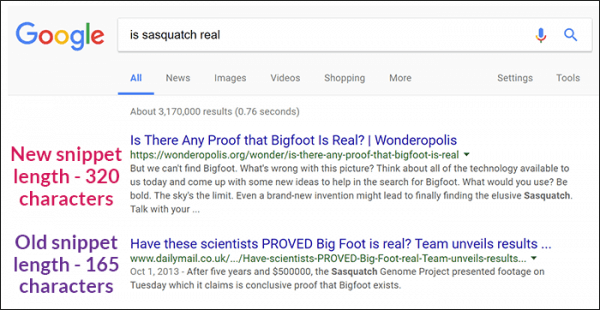 Google recently updated their algorithm to embrace longer “snippets,” the explanatory text that appears below your organic listings on search engine results pages (SERPs). Their previous max length was 165 characters; now it can go up to 320 or higher. But what does that mean for your company’s website?
Google recently updated their algorithm to embrace longer “snippets,” the explanatory text that appears below your organic listings on search engine results pages (SERPs). Their previous max length was 165 characters; now it can go up to 320 or higher. But what does that mean for your company’s website?
How did this happen?
Google had been experimenting with showing longer snippets under some listings for months, but around Nov. 22, the practice became widespread and apparently permanent. According to SISTRIX, by Dec. 4, 51% of the snippets on the first page of results were using the longer format.
A Google spokesperson confirmed the shift:
We recently made a change to provide more descriptive and useful snippets, to help people better understand how pages are relevant to their searches. This resulted in snippets becoming slightly longer, on average.
Where is Google getting the text for these longer snippets?
In what one employee describes as a “dynamic process,” Google now searches pages for content that aligns best with a searcher’s query and intent and posts up to 320 characters of that as the snippet. Theoretically, the content could come from anywhere on the page, but in many cases, the snippet text has been taken from the first text content on the page.
Should you dispatch your SEO team to start rewriting meta descriptions immediately?
In his blog post about this development, Barry Schwartz, longtime expert on search engine marketing, surmised that changing meta descriptions could be counterproductive:
Some webmasters and SEOs may consider updating their meta descriptions, but I don’t believe Google would recommend doing so. The snippets are more often dynamically generated based on the user query and content found in both the meta description and the content visible on the page. If Google is going to go with a longer snippet, it likely will pull that content from the page.
Danny Sullivan at Google agreed with Schwartz (@rustybrick) in a tweet and reinforced that the search engine isn’t looking to meta descriptions for snippet text anymore.
UPDATE: Google has clarified its position on meta descriptions, both through an official statement and through this verbal explanation from team member John Mueller:
“For the descriptions that we show, we try to focus on the meta description that you provide on your pages, but if we need more information or more context based on the user’s query, perhaps then we can take some parts of the page as well. … I definitely see it as something legitimate where you might say, ‘Well, I want to make sure that my kind of proposition is out there in full, and therefore I’ll try to write something a bit longer and show that in my meta description.’ “
What should you do in response to this change?
As noted above, the content most often chosen for the snippet text is the first paragraph or so on the page. So you should focus on the first paragraph on every page, right? Not quite.
The first thing you and your SEO team or agency should do is to review your site to make sure each page:
- Aligns with the search terms a potential customer would use AND
- Addresses a specific searcher intent (informational, transactional, investigational, etc.)
This process can reveal gaps in content, also known as opportunities to optimize your site and provide more value to users. For larger sites, focus first on your highest-converting pages, as optimizing them can yield the greatest results.
Make sure each page has a strong first paragraph that provides enough information to show a searcher that this page has the answer they’re looking for, but not so much information that the snippet answers all the searcher’s questions. A top-level answer followed by the promise of more information is one classic format that works as both an introduction and a snippet.
Then, address your meta descriptions:
- Review each description for accuracy, alignment with page content, and language that would entice a searcher
- Rewrite the description as necessary, ideally into two sentences:
- A strong, accurate, appropriate description in 150 to 165 characters
- Why? Because while Google has adjusted its approach to snippets and their length, Bing still takes snippets direct from meta descriptions and holds them to their original length
- Then another sentence of similar length with additional information and enticing language for Google to display (possibly)
- A strong, accurate, appropriate description in 150 to 165 characters
We’ll keep carefully monitoring snippets and search results to see if any significant changes in rankings or CTRs result from this change, and report back to you with the results.

